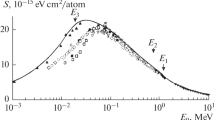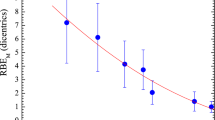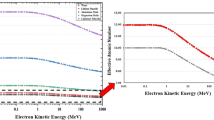Abstract
Radiobiological experiments with the irradiation of various biological samples by nuclei from boron to neon with a primary energy of 30–50 MeV/nucleon are performed on the U400M cyclotron of the Laboratory of Nuclear Reactions, Joint Institute for Nuclear Research. The linear energy transfer (LET) of the nuclei in samples is calculated using the code Lise++. For reducing the energy of nuclei and increasing their LET, aluminum filters with different thickness are placed before samples. The presence of filters and other absorbers before a sample results in the production of secondary charged particles whose LET may strongly differ from the LET of primary nuclei of the beam. This also affects the accuracy of calculating the absorbed dose. For this reason, detailed calculations of particle fields in samples are performed using the Monte Carlo code for radiation transport in matter PHITS 3.20 for several variants of sample irradiation with thick absorbers before samples. The calculated LET distributions are analyzed and compared with the calculations using the code Lise++.







Similar content being viewed by others
REFERENCES
A. A. Bezbakh, V. B. Zager, G. Kaminski, A. I. Krylov, V. A. Krylov, Yu. G. Teterev, and G. N. Timoshenko, “Upgrading the genome facility for radiobiological experiments with heavy ion beams,” Phys. Part. Nucl. Lett. 10, 175–178 (2013).
O. Tarasov and D. Bazin, “LISE++: Radioactive beam production with in-flight separators,” Nucl. Instrum. Methods Phys. Res., Sect. B 266, 4657–4664 (2008).
D. Bazin, O. Tarsov, M. Lewitowitz, and O. Sorlin, “The program LISE: A simulation of fragment separators,” Nucl. Instrum. Methods Phys. Res., Sect. A 482, 307–327 (2002).
H. Weick et al., “Slowing down of relativistic few-electron heavy ions,” Nucl. Instrum. Methods Phys. Res., Sect. B 164–165, 168–179 (2000).
F. Ziegler et al., SRIM2000 (Pergamon, New York, 1985). www.research.ibm.com/ionbeams/#SRIM.
T. Sato et al., “Features of particle and heavy ion transport code system (PHITS), version 3.02,” J. Nucl. Sci. Technol. 55, 684–690 (2018).
A. Boudard et al., “The INCL model,” Phys. Rev. C 87, 014606 (2013).
H. Hirayama et al., “The EGS code,” SLAC-R-730 (2005);
KEK Report 2005-8 (2005).
K. Iida, A. Kohama, and K. Oyamatsu, “Formula for proton-nucleus reaction cross section at intermediate energies and its application,” J. Phys. Soc. Jpn. 76, 044201 (2007).
T. Ogawa, T. Sato, S. Hashimoto, D. Satoh, S. Tsuda, and K. Niita, “Energy-dependent fragmentation cross sections of relativistic 12C,” Phys. Rev. C 92, 024614 (2015).
Author information
Authors and Affiliations
Corresponding author
Additional information
Translated by E. Baldina
Rights and permissions
About this article
Cite this article
Timoshenko, G.N., Gordeev, I.S. Calculating the Linear Energy Transfer Distribution in Radiobiological Experiments on the U400M Cyclotron. Phys. Part. Nuclei Lett. 17, 951–957 (2020). https://doi.org/10.1134/S1547477120070055
Received:
Revised:
Accepted:
Published:
Issue Date:
DOI: https://doi.org/10.1134/S1547477120070055




